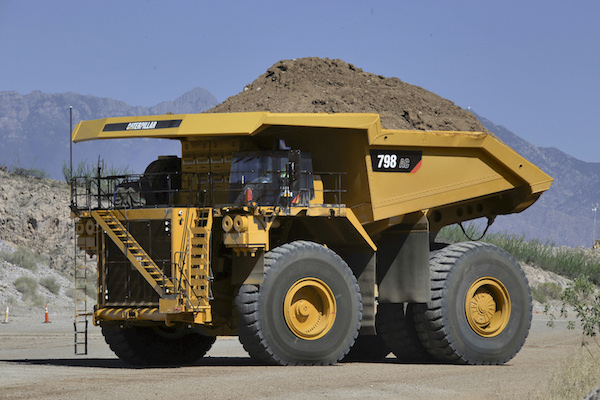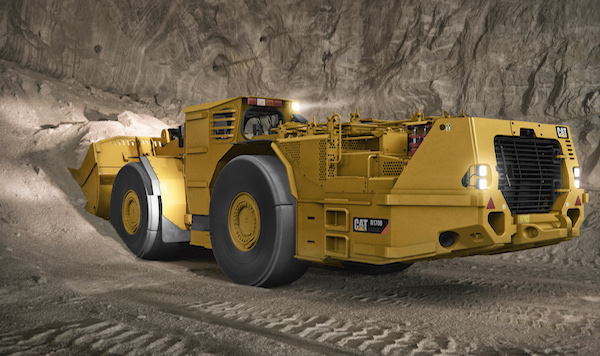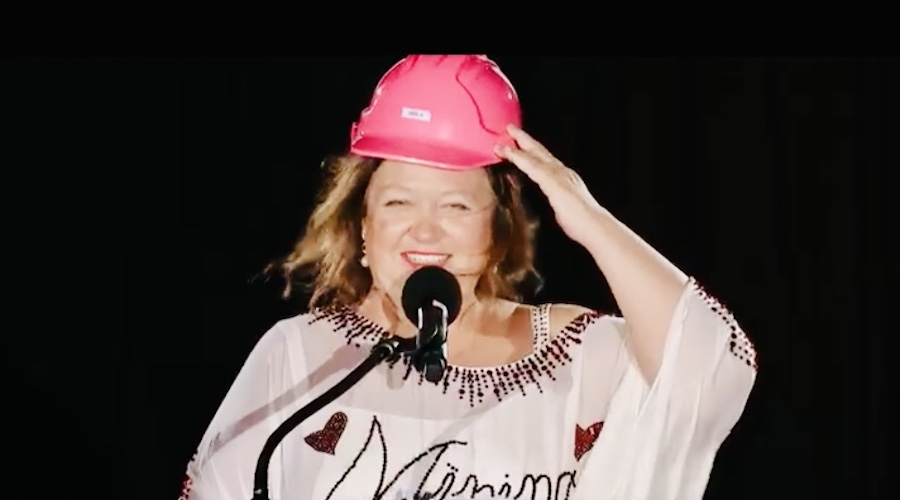Caterpillar steps up game to keep leadership in North America

With the introduction of the new Cat 798 AC, Caterpillar expands its mining truck line to give customers the flexibility to choose what meets their needs and preferences. (Image supplied.)
When Komatsu acquired Joy Global in 2016, the Japanese firm expanded its portfolio from surface to underground mining equipment, becoming the strongest competitor in the North American market for Caterpillar, the world’s No.1 heavy machinery maker.
Since then, Caterpillar has been working on growing its offering, particularly in the underground segment, as well as filling up some gaps in terms of trucks sizes.
“Five out of our 10 most popular underground equipment are either new or have been upgraded in the last two years,” Susan Gaugush, commercial manager for underground machinery, said.
Among the newest additions to Cat’s mining offering, presented to trade press at the company’s test grounds in Arizona, is the R1700, first introduced at MINExpo 2016 and finally coming to the market next year.
A recent head-to-head study and multiple field trials show the R1700 exceeds its payload advantage in faster truck loading and more productive load-and-carry operations, while delivering 21% less fuel consumption per hour, Gaugush said.
She described the R1700 loader as the first “truly new” piece of underground mining equipment Caterpillar has introduced in the past two years.
The company also revealed more details about its two new ultra-class electric drive mining trucks — the Cat 798 AC and Cat 796 AC.
In the past two years, Caterpillar has been working on growing its offering, particularly in the underground segment, as well as filling up some gaps in terms of trucks sizes.
The equipment giant, which is relocating its mining division from Peoria Illinois to Tucson, Arizona, beginning in the second quarter of 2019, said the decision to add the new models to its float was based on offering customers more options at the highest end of its payload scale for both electric and mechanical drive.
The 798 AC features a 372-tonne payload and joins the mechanical-drive Cat 797F in the 400-short-tonne size class. According Jeff Castleman, in charge of new product introduction in the large mining trucks range, Caterpillar was able to move from design to production of the 798 AC in just one year.
The executive also noted the 796 AC was likely to act as a replacement for the 795 AC, which won’t be offered in Tier 4 Final configuration. Tier 4 standards refers to governments-mandated reductions in harmful exhaust gases for diesel powered equipment, currently imposed in the US, Canada and, most recently, in China and India.
Big bet in autonomy
Caterpillar is also stepping up efforts to provide more and better autonomous offerings, with the goal of making its entire large mining truck class autonomy-ready. That includes the newly-added electric drive 796 AC and 798 AC haul trucks.
The company, which only tapped into the autonomous trend five years ago, already has seven driverless haul fleets around the globe, Sudhanshu Singh, Global Product Manager, Trucks said.
He noted that an eighth will come online next year at Fortescue Metal Group’s Cloudbreak iron ore mine in Western Australia.

The Cat R1700 Underground Mining Loader now has a completely new design, which has proven its high productivity and efficiency in extended field trials and in production studies. (Image supplied.)
“We have now the second largest autonomous fleet operating at a mine, moving an average of over 2 million tonnes of ore,” Jean Savage, VP Surface Mining and Technology, told reporters at Tinajas Hill, when unveiling Cat’s plans on the subject.
What sets Cat’s offering in the autonomous segment apart from main rivals, Savage added, is that the firm is able to integrate competitors’ technology into its own systems. Something that according to Savage, other equipment makers don’t offer.
The move towards making all of its large mining trucks autonomy-ready is a reflection of what customers are asking for, Savage said, as mining operators are realizing they can continue to reach production goals with smaller machines than previously used in manned operations.
Jim Grooss, trucks specialist, said customers still request autonomous trucks with cabins for drivers. “They want to have the choice of running them in manual mode, if they want to,” he says, noting that the next generation of driverless trucks is “very likely” to be “cabin-less”.
Sales of giant yellow machinery began climbing last year, following steep declines between 2012 and 2016 that forced a major restructuring. The company has repeatedly revised annual revenue and profit projections upward as quarterly earnings reports have beat Caterpillar’s and analysts’ forecasts. The equipment manufacturer has posted record quarterly profit figures in each of three consecutive reports so far this year.
And while the mining sector has still ways to go in terms of buying new machinery as opposed to only upgrading current fleets, Sudhanshu Singh said most of the sales growth is coming from the copper and iron ore sectors, and — increasingly — from coal producers, given the increasing number of expansion projects and new greenfield developments.
* Cecilia Jamasmie attended a special event for trade publications at Caterpillar’s test grounds in Tucson, Arizona.
{{ commodity.name }}
{{ post.title }}
{{ post.date }}

Comments
Donald Mccauley
Who could have guessed Caterpillar was a major target in the Odumbo administration since they both called Illinois home. The diesel restrictions placed on the United States by EU mandated standards drove them clear out of US highway market from leader in the industry. Maintenance on the pollution systems costs easily $1000.00 per month in repairs, and effecincy has gone down from 7mpg to 5mpg or less. How is that better? As of now, nearly all “compliant” engines built here have to have German/Dutch components and technology to meet requirements ( Bosch or Mann) to name a few, even on Caterpillar designed units. President Trump will likely be stymied with a Democrap house to block his intentions of making changes to get the Euro-global influence out of American business. This country was built with American bulldozers, not Panzers.